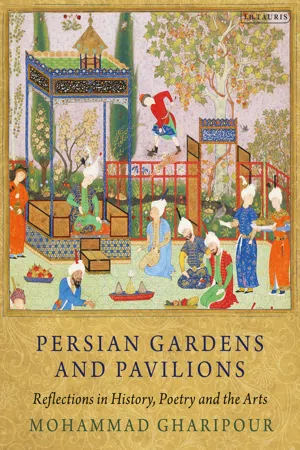
Persian Gardens and Pavilions
Reflections in History, Poetry and the Arts
- 256 pages
- English
- ePUB (mobile friendly)
- Available on iOS & Android
About This Book
From Timur's tent in Samarqand to Shah 'Abbas's palace in Isfahan and Humayun's tomb in Delhi, the pavilion has been an integral part of Persianate gardens since its earliest appearance at the Achaemenid garden in Pasargadae in the sixth century BC. Here, Mohammad Gharipour places both the garden and the pavilion within their historical, literary and artistic contexts, emphasizing the importance of the pavilion, which has hitherto been overlooked in the study of Iranian historical architecture. Starting with an examination of the depictions and representations of gardens in religious texts, Gharipour analyses the how the idea of the garden developed from the model of pre-Islamic gardens in Achaemenid and Sassanian Persia to its mentions in the Zoroastrian text of Aban Yasht and on to its central role as paradise in the Qur'an. Continuing on with an exploration of gardens and pavilions in Persian poetry, Gharipour offers in-depth analysis of their literal and metaphorical values. It is in the poetry of major Persian poets such as Ferdowsi, Naser Khosrow, Sa'di, Rumi and Hafez that Gharipour finds that whilst gardens are praised for their spiritual values, they also contain significant symbolic worth in terms of temporal wealth and power. Persian Gardens and Pavilions then goes onto examine the garden and the pavilion as reflected in Persian miniature painting, sculpture and carpets, as well as accounts of travelers to Persia. With masters such as Bizhad representing daily life as well as the more mystical prose and poetry in, for example, Sa'di's Bustan (The Orchard) and Golestan (The Rose Garden), the garden and the pavilion can be seen to have crucial semiotic significances and cultural meanings. But in addition to this, they also point to historical patterns of patronage and ownership which were of central importance in the diplomatic and social life of the royal courts of Persia. Gharipour thereby highlights the metaphorical, spiritual, symbolic and religious aspects of gardens, as well as their more materialistic and economic functions. This book reaches back through Persia's rich history to explore the material and psychological relationships between human beings, pavilions and gardens, and will be a valuable resource for Art History, Architecture and Iranian Studies.
Frequently asked questions
Information
Table of contents
- Cover
- Title Page
- Dedication
- Contents
- List of Illustrations
- Acknowledgements
- 1 Introduction
- 2 The Garden and Pavilion in Near Eastern Pre-Islamic Texts, the Qur’an and Persian Poetry
- 3 The Garden and Pavilion in Persian Art
- 4 The Garden and Pavilion through the Lens of Travellers and Historians
- 5 Conclusion
- Matrix
- Glossary of Terms
- Poets, Historians and Travellers
- Notes
- Bibliography
- Index
- Image
- eCopyright